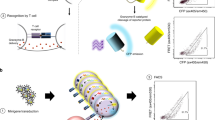Abstract
Phage library clones selected by a conformational epitope-recognizing and inhibitory monoclonal antibody may display moieties that mimic a receptor/ligand-like three-dimensional structure. This pseudoreceptor/ligand should be able to bind to natural ligand/receptor molecules. We tested this idea using anti-T cell costimulatory molecule antibodies and successfully isolated phage clones with costimulatory effects on T-cell proliferation. This strategy facilitates the designing of regulatory peptide molecules in the absence of precise information about the structure-function relationships in receptor/ligand interactions.
This is a preview of subscription content, access via your institution
Access options
Subscribe to this journal
Receive 12 print issues and online access
$209.00 per year
only $17.42 per issue
Buy this article
- Purchase on Springer Link
- Instant access to full article PDF
Prices may be subject to local taxes which are calculated during checkout
Similar content being viewed by others
References
Bachan, D., Balas, M., Souroujon, M.C., Katchalski-Katzir, E., and Fuchs, S. 1995. Identification of epitopes within a highly immunigenic region of acetylcholine receptor by a phage epitope library. J. Immunol. 155:4264–4269.
Koivunen, E., Wang, B., and Ruoslahti, E. 1994. Isolation of a highly specific lig-andforthea‘b’ integrin from a phage display library. J. CellBiol. 124:3733–3780.
Yayon, A., Aviezer, D., Safran, M., Gross, J.L., Heldman, Y., Cabilly, S. et al. 1993. Isolation of peptides thatinhibit binding of basic fibroblast growth factor to its receptor from a random phage-epitope library. Proc. Natl. Acad. Sci. USA 90:10643–10647.
Linsley, P.S. 1995. Distinct roles for CD28 and cytotoxic T lymphocyte-associated molecule-4 receptors during T cell activation. J.Exp. Med. 182:289–292.
Thompson, C.B. 1995. Distinct roles for the costimulatory ligands B7-1 and B7-2 in T helper cell differentiation. Cell, 81:979–982.
Gribben, J.G., Freeman, G.J., Boussiotis, V.A., Rennert, P., Jellis, C.L., Greenfield, E. et al. 1995. CTLA4 mediates antigen-specific apoptosis of human T cells. Proc. Natl. Acad. Sci.USA 92:811–815.
Lenschow, D.J., Zeng, Y., Thistlethwaite, J.R., Montag, A., Brady, W. et al. 1992. Long-term survival of xenogeneic pancreatic oslet grafts induced by CTLA4lg. Science 257:789–792.
Linsley, P.S., Wallace, P.M., Johnson, J., Gibson, M.G., Greene, J.L., Ledbetter, J.A. et al. 1992. Immunosuppression in vivo by a soluble form of the CTLA-4 T cell activation molecule. Science 257:792–794.
Morton, P.A., Fu, X.T., Stewart, J.A., Giacoletto, K.S., White, S.L., Leysath, C.E. et al. 1996. Differential effects of CTLA-4 substitutions on the binding of human CD80 (B7-1) and CD86 (B7-2). J. Immunol. 156:1047–1054.
Walunas, T.L., Bakker, C.Y., and Bluestone, J.A. 1996. CTLA-4 ligation blocks CD28-dependent T cell activation. J.Exp, Med. 183:2541–2550.
Krummel, M.F. and Allison, J.P. 1995. CD28 and CTLA-4 have opposing effects on the response of T cells to stimulation. J. Exp. Med. 182:459–465.
Parmley, S.F. and Smith, G.P. 1988. Antibody-selectable filamentous fd phage vectors: affinity purification of target genes. Gene 33:305–318.
Nishi, T., Budde, R.J., McMurray, J.S., Obeyesekere, N.U., Safdar, N., Levin, V.A. et al. 1996. Tight-binding inhibitory sequences against pp60c-src identified using a random 15-amino-acid peptide library. FEBS Lett. 399:237–240.
Wuttke, G.G., Keppner, J., and Rasched, I. 1989. Pore-forming properties of the adsorption protein of filamentouse phage fd. Biochim. Biophys. Acta 985:239–247.
Smith, G.P. 1991. Surface presentation of protein epitopes using bacteriophage expression systems, Curr. Opin. Biotech. 2:668–673.
Wrighton, N.C., Farrell, F.X., Chang, R., Kashyap, A.K., Barbone, F.P., Mulcahy, L.S. et al. 1996. Small peptides as potent mimetics of the protein hormone ery-thropoietin. Science 273:458–463.
Cwirla, S.E., Balasubramanian, P., Duffin, D.J., Wagstrom, C.R., Gates, C.M., Singer, S.C. et al. 1997. Peptide Agonist of the Thrombopoietin Receptor as Potent as the Natural Cytokine. Science 276:1696–1699.
Welply, J.K., Steininger, C.N., Caparon, M., Michener, M.L., Howard, S.C., Pegg, L.E. et al. 1996. A peptide isolated by phage display binds to ICAM-1 and inhibits binding to LFA-1. Proteins 26:262–270.
Rennert, P., Furlong, K., Jellis, C., Greenfield, E., Freeman, G.J., Ueda, Y. et al. 1997. The IgV domain of human B7-2 (CD86) is sufficient to costimulate T lymphocytes and induce cytokine secretion. Int. Immunol. 9:805–813.
Waterhouse, P., Penninger, J.M., Timms, E., Wakeham, A., Shahinian, A., Lee, K.P. et al. 1995. Lymphoproliferative disorders with early lethality in mice deficient in Ctla-4. Science 270:985–988.
Borriello, F., Sethna, M.P., Boyd, S.D., Schweitzer, A.N., Tivol, E.A., Jacoby, D. et al. 1997. B7-1 and B7-2 have overlapping, critical roles in immunoglobulin class switching and germinal center formation. Immunity 6:303–313.
Murakami, M., Takahashi, Y., Isashi, Y., Kon, S., Jia, W.Y., Inobe, M. et al. 1996. Identification and characterization of an alternative CTLA4 binding molecule (ACBM) on B cells. Proc. Natl. Acad. Sci. USA 93:7838–7842.
Mizushima, S. and Nagata, S. 1990. pEF-BOS, a powerful mammalian expression vector. Nucl. Acids Res. 18:5322
Inobe, M., Linsley, P.S., Ledbetter, J.A., Nagai, Y., Tamakoshi, M. and Uede, T. 1994. Identification of an alternatively spliced form of the murine homologue of B7. Biochem. Biophys. Res. Com. 200:443–449.
Hashiguchi, S., Hino, S., Taniguchi, Y., Kurimoto, M., Fukuda, K., Ohyama, M. et al. 1996. Immunodominance of seven regions of a major allergen, Cry j 2, of Japanese cedar pollen for T-cell immunity. Allergy 51:621–632.
Author information
Authors and Affiliations
Corresponding author
Rights and permissions
About this article
Cite this article
Fukumoto, T., Torigoe, N., Kawabata, S. et al. Peptide mimics of the CTLA4-binding domain stimulate T-cell proliferation. Nat Biotechnol 16, 267–270 (1998). https://doi.org/10.1038/nbt0398-267
Received:
Accepted:
Issue Date:
DOI: https://doi.org/10.1038/nbt0398-267



